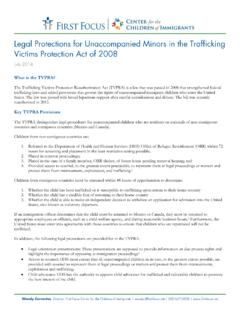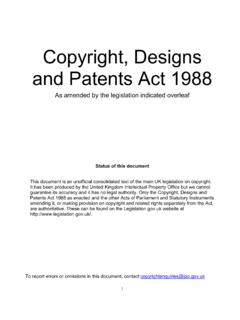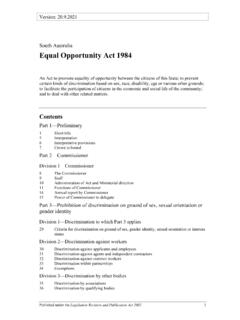Transcription of History of U.S. Children’s Policy, 1900-Present
1 First Focus | 1. BY ANDREW L. YARROW, PUBLIC AGENDA APRIL, 2009 Children are our most valuable natural resource. - President Herbert Hoover1 It must not for a moment be forgotten that the core of any social plan must be the child.
2 - President Franklin Roosevelt2 uring the last century since the Progressive Era and the first White House Conference on Children in 1909 the federal government has vastly expanded its role in promoting the welfare of America s children and youth. While families remain the bulwark for successful child development, and states, localities, and a host of private entities provide services to infants, children, youth, and their families, the federal government has long supported and provided services ranging from health care to education and enforces a wide range of laws and regulations to protect and enhance the well-being and rights of Americans under age This essay offers a brief survey of the development of federal policies affecting children and families from the early 20th century to the early 21st century.
3 The focus is on federal legislation and important federal court decisions; state policy developments largely are excluded. THE AMERICAN CHILD IN 1900: THE SETTING FOR PROGRESSIVE REFORM The turn of the 20th century was a time of profound transition both in the status of children in American life and in the role of the federal government in child policy. Childhood increasingly was seen as a developmentally distinct stage of life, and children were viewed with greater tenderness reflecting a new, middle class belief in childhood s importance and concern with children s Concurrently, the federal government was becoming much more involved in implementing policies to promote the welfare of Americans, young and old.
4 Social dislocations of the late 19th century, sparked by rapid industrialization, population growth, urbanization, and immigration, together with the economic crises of the late 1870s and 1890s, led to social reform movements in the 1890s and during the Progressive Era at the beginning of the 20th century. With respect to children, many reformers became part of a diffuse child-saving movement to combat the real and perceived problems of poor child health, abusive child labor, delinquency, poverty, failed families, and the institutionalization D History of Children s Policy, 1900-Present First Focus | 2.
5 Of children. Progressivism, which had many strands, encompassed private and public-sector efforts to ameliorate suffering and injustices; a new faith in the ability of science to address social problems; and strengthening the moral fiber of Americans of all ages. These threads informed much of the advocacy and federal and state policy in areas ranging from child labor and education to care of dependent children and child and maternal health. Indeed, at the turn of the 20th century, child mortality rates were high, millions of children were employed, school attendance was low, poverty was widespread, and countless children dependent on the community languished in almshouses and orphanages.
6 Such institutions, created in part to house Civil War orphans, were already in decline by 1900, as reformers sought to place orphans as well as many children in poor families in either child-specific institutions or middle-class homes as foster children. By 1910, more than 1,150 institutions, with varying conditions, held 150,000 children. The health of young children was abysmal by modern standards, as about 1 in 4 children in 1900 died by age 5. Likewise, two million children between the ages of 10 and 15 worked in factories, on farms, and on urban streets.
7 At the same time, educational reformers debated the relative merits of seeing education as a mechanism for social and moral change, as John Dewey argued, or more strictly as a process to instill basic knowledge and cultivate needed skills. School attendance and the number of schools had increased sharply between 1870 and 1900, yet only 8 percent of high school-age children were in school in 1900, and most children of all ages attended school only irregularly. While vast strides in expanding school attendance occurred during the first two decades of the 20th century, little of this progress could be attributed to federal policy.
8 The Bureau of Education, established in the Department of the Interior after the Civil War, served mainly to collect school enrollment and financial data. 5 1909 WHITE HOUSE CONFERENCE ON THE CARE OF DEPENDENT CHILDREN The first White House conference on children grew out of growing public sentiment to protect the welfare of dependent children. The 1909 conference, conceived and organized by lawyer James West for President Theodore Roosevelt, focused on the harmful effects of institutionalizing dependent and neglected children, and urged the promotion of child well-being within families and by private charities , rather than by government.
9 Reacting to the horrors of almshouses and orphanages, the 200 attendees concurred that poverty alone should not be a reason for removing children from their families. The conference issued nine major proposals, among them to establish a national foster care program, expand adoption agencies, and provide mothers pensions to keep poor families intact. This last recommendation was adopted by 20 state legislatures between 1911 and 1913. Attendees and social reformers such as consumers and workers advocate Florence Kelley and Lillian Wald, organizer of the Henry Street Settlement in New York, also won Roosevelt s support for creating the first federal children s agency dedicated to protecting the welfare of the nation s children.
10 First Focus | 3. THE CHILDREN S BUREAU Massachusetts Sen. Winthrop Crane introduced legislation to create a federal Children s Bureau, first in 1906 and again after the 1909 White House Conference. Its proposed mission was to monitor state legislation affecting children, and to gather and disseminate data on child welfare. Earlier, private charities and states had initiated efforts to protect children during the 19th century, but many states even into the early 20th century bundled child protection with animal protection or boards of correction, or both.







